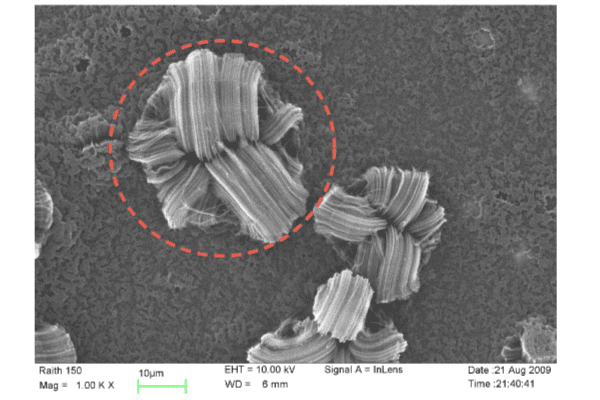Michael Forney

Michael Forney

Carbon nanotube growth, dispersion, and use in nanoelectromechanical actuators
Abstract:
The body of research comprising this dissertation spans the full spectrum of carbon nanotube (CNT) research: growth of CNTs, dispersion of SWNTs, controlled aggregation of SWNTs, and fabrication of CNT-based actuators. CNTs have been grown in our lab by chemical vapor deposition (CVD) and characterized by SEM and Raman spectroscopy. After growth, CNTs can be dispersed into a liquid for spectroscopic characterization or use in directed self-assembly, composites, or devices.
An important component of the dispersion research was focused on dispersing SWNTs into polar aprotic solvents containing methyl groups, where inappropriate ultrasonication conditions can initiate the sonochemical formation of methyl hydroperoxide, which destabilizes SWNT dispersions. This discovery was novel and had not been reported in the literature previously. That project lead to a careful study of SWNT dispersion stability at the “onset of aggregation”, when ionic coagulants are added, in pure and mixed solvents. We found that optimizing bulk solvent parameters can enhance the stability of SWCNT dispersions in mixed solvents, which had not been published in the literature. After studying the “onset of aggregation”, we studied critical coagulation concentrations (CCCs), which occur at much higher coagulant concentrations than the “onset of aggregation”. We found that optimizing bulk solvent parameters does not enhance dispersion stability at the CCC. We also observed “transient stability” in dispersions that had NMP as the solvent or co-solvent. Computational work predicted that transient effects should be experimentally observable in NMP dispersions, but no experimental research has been published to support this prediction.
We have grown aligned CNT arrays onto microcantilever arrays to fabricate microcantilever-based actuators. This type of nano/microscale actuator has not been demonstrated in the literature. Also, we anticipate that these actuators will enable significantly larger microcantilever deflections than microcantilever actuators that employ other methods of force transduction. The CNT/microcantilever actuators developed in this project will provide an architecture that could be useful in applications such as nanovalves, release of drugs from a capsule, or nano-manipulation.
Sponsoring Chair: Dr. Jordan Poler
Committee: Dr. James Amburgey, Dr. Patrick Moyer, Dr. Stuart Smith, Dr. Edward Stokes, Dr. Qiuming Wei